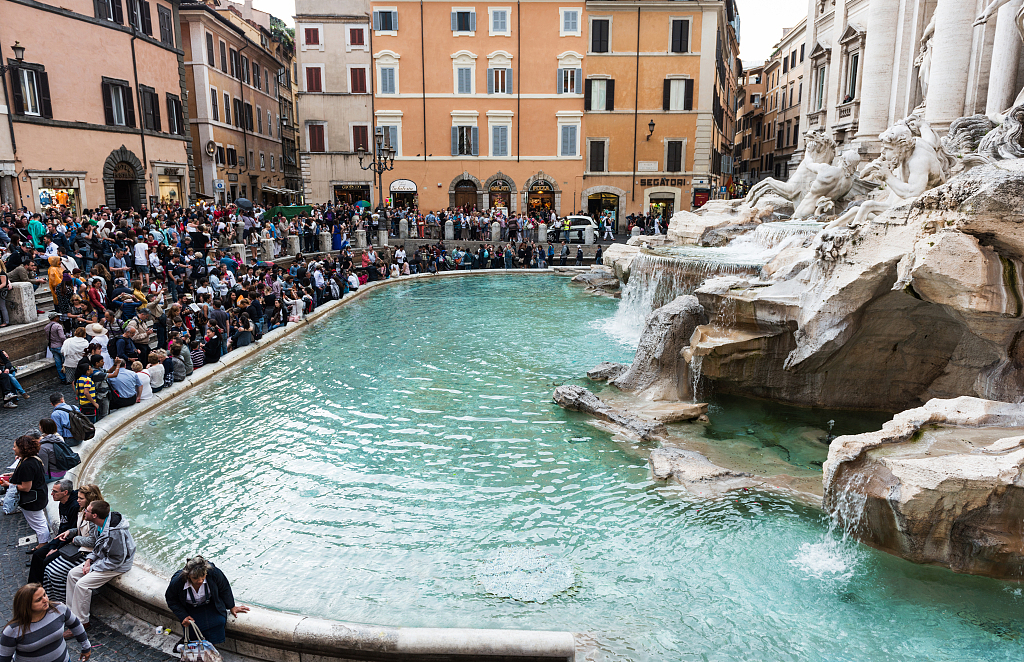The Trevi Fountain History, Design, and Cultural Significance The Trevi Fountain( Italian Fontana di Trevi) is an 18th-century root in the Trevi quarter in Rome, Italy, designed by Italian mastermind Nicola Salvi and completed by Giuseppe Pannini in 1762 and several others. Standing 26.3 meters ( 86 ft) high and 49.15 meters (161.3 ft) wide, it’s the largest Baroque root in the megacity and one of the most notorious cradles in the world.
History before 1629

The root, at the junction of three roads( tre vie),marks the terminal point of the” ultramodern” Acqua Vergine — the revived Aqua Virgo, one of the courses that supplied water to ancient Rome. In 19 BC, apparently with the help of an abecedarian, Roman technicians located a source of pure water some 13 km(8.1 mi) from the megacity. ( This scene is presented on the present root’s façade.) Still, the eventual circular route of the conduit made its length some 22 km( 14 mi). This Aqua Virgo led the water into the cataracts of Agrippa. It served Rome for further than 400 times.
Name origin
The name of the root derives from the Latin word trivium( crossroad of three thoroughfares). The statues are located right in the center of Via De’ Crocicchi, Via Poli, and Via Delle Muratte.
Roman courses
During the sixth century, the courses weren’t well maintained and the 14 performing bones were damaged during the irruption of the Ostrogoths. ( citation demanded)
The virgin water conduit carries the water to the Trevi Fountain, after having collected it 10 km from the Italian capital. ( citation demanded)

The conduit is still in use moment, despite some interventions during which the root remained empty. Calcium-free water is allowed to be one of the causes(further explanation demanded).
Commission, construction, and design
In 1629, Pope Urban VIII, chancing the earlier root rightly dramatic, asked Gian Lorenzo Bernini to sketch possible emendations, but the design was abandoned when the Pope failed. Though Bernini’s design was noway constructed, there are numerous Bernini touches in the root as it exists moment. An early influential model by Pietro da Cortona, saved in the Albertina, Vienna, also exists, as do colorful early 18th century sketches, utmost unsigned, as well as a design ascribed to Nicola Michetti one ascribed to Ferdinando Fuga and a French arrangement by Edme Bouchardon.
Competitions had become popular during the Baroque period to design structures, cradles, as well as the Spanish way. In 1730, Pope Clement XII organized a contest in which Nicola Salvi originally lost to Alessandro Galilei – but due to the roar in Rome over a Florentine having won, Salvi was awarded the commission anyway. Work began in 1732.

Salvi failed in 1751 with his work half finished, but he’d made sure a hairstylist’s uncomely sign would not spoil the ensemble, hiding it behind a sculpted vase, called by Romans the asso di coppe, the” Ace of Mugs”, because of its common denominator to a Tarot card. Four different sculptors were hired to complete the root’s decorations Pietro Bracci( whose statue of Oceanus sits in the halfway niche), Filippo della Valle, Giovanni Grossi, and Andrea Bergondi. Giuseppe Panini ( 1718- 1805), son of Giovanni Paolo Panini, was hired as mastermind.
The Trevi Fountain was finished in 1762 by Pannini, who substituted the present apologies for planned puppets of Agrippa and Trivia, the Roman abecedarian. It was officially unclosed and inaugurated on 22 May by Pope Clement XIII.
The maturity of the piece is made from Travertine gravestone, excavated near Tivoli, about 35 kilometers ( 22 long hauls) east of Rome.
Restoration
The root was refurbished formerly in 1988 to remove abrasion caused by gauze, and again in 1998; the stonework was dropped and all cracks and other areas of deterioration were repaired by professed crafters, and the root was equipped with recirculating pumps.
In January 2013, it was blazoned that the Italian fashion company Fendi would finance a 20-month, 2.2-million-euro restoration of the root; it was to be the most thorough restoration in the root’s history.
Restoration work began in June 2014 and was finished in November 2015. The root was restarted with a sanctioned form on the evening of 3 November 2015. The restoration included the installation of further than 100 LED lights to ameliorate the darkness illumination of the root.
2023 kick
On May 21, 2023, activists of the climate group Ultima Generazione( Last Generation) climate kick group defaced the root by dying the water with watercolor. Rome Mayor Roberto Gualtieri blamed the attacks on heritage spots. As the root recirculates the water, cleaning of the root would require the 300,000 liters of weakened water to be voided and replaced performing significant costs. Ryan Maue, the former principal scientist for the National Oceanic and Atmospheric Administration, stated the attack was done by” climate-anarchists”.
Iconography
The background for the font is the Palazzo Poli, given a new façade with a giant order of Corinthian floats that link the two main stories. reining of the waters is the theme of the gigantic scheme that tumbles forward, mixing water and rockwork, and filling the small forecourt. Tritons guide Oceanus’s shell chariot, reining hippocamps.
In the center, a robustly- modeled triumphal arc is superimposed on the palazzo façade. The center niche or exedra framing Oceanus has free-standing columns for minimum light and shade. In the niches bordering Oceanus, Cornucopia tumbles water from her charnel and Salubrity holds a mug from which a snake drinks. Above, bas reliefs illustrate the Roman origin of the courses.
The Tritons and nags give symmetrical balance, with the maximum discrepancy in their mood and acts( citation demanded)( by 1730, Rococo was formerly in full bloom in France and Germany).
Coin throwing
Coins are purportedly meant to be thrown using the accurate hand over the left shoulder. This was the topic of 1954’s Three Coins in the Fountain and the Academy Award-winning song by that title which introduced the picture.
An estimated 3,000 euros are thrown into the root each day. In 2016, an estimated€1.4 million(US$1.5 million) was thrown into the root. The plutocrat has been used to subsidize a supermarket for Rome’s poor; still, there are regular attempts to steal coins from the root, indeed though it’s illegal to do so.
In popular culture
This section needs fresh citations for verification. Please help ameliorate this composition by adding citations to dependable sources in this section. Unsourced material may be challenged and removed. ( May 2022)( Learn how and when to remove this template message)
Anita Ekberg wading into the root in the film La Dolce Vita( 1960)

The root has appeared in several flicks, including Roman Holiday( 1953); Three Coins in the Fountain( 1954); Federico Fellini’s classic, La Dolce Vita( 1960); Sabrina Goes to Rome( 1998); and The Lizzie McGuire Movie( 2003).
The Trevi Fountain is depicted in the third movement,” The Trevi Fountain at Noon”, of Ottorino Respighi’s 1916 euphonic lyric Cradles of Rome.
In Federico Fellini’s 1960 film La Dolce Vita, Anita Ekberg wades into the roots with Marcello Mastroianni.
In 1973, the Italian public postal service devoted a postage stamp to the Trevi Fountain.
Replica

An 11 m high and 20.6 m wide analogous façade construction as a monument was erected in 2023 at Serra Negra, Brazil.
Another dupe is located near Caesars Palace in Las Vegas, and yet another replica can be set up in the Jamsil station of the Seoul Metro Subway.




